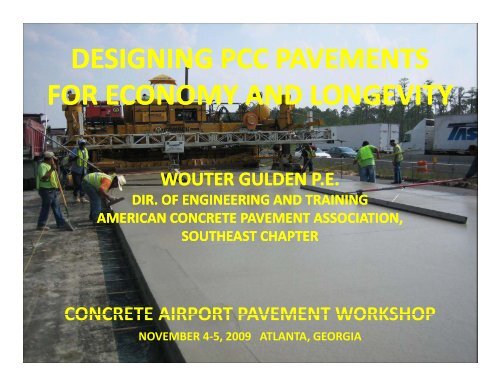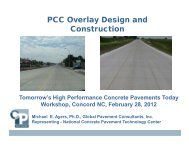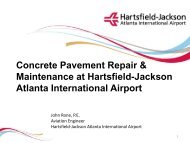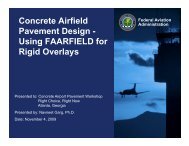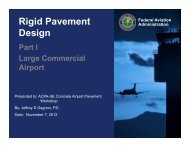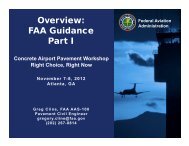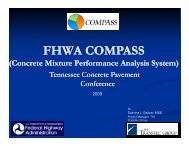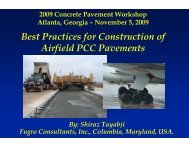designing pcc pavements for economy and longevity - American ...
designing pcc pavements for economy and longevity - American ...
designing pcc pavements for economy and longevity - American ...
You also want an ePaper? Increase the reach of your titles
YUMPU automatically turns print PDFs into web optimized ePapers that Google loves.
DESIGNING PCC PAVEMENTS<br />
FOR ECONOMY AND LONGEVITY<br />
WOUTER GULDEN P.E.<br />
DIR. OF ENGINEERING AND TRAINING<br />
AMERICAN CONCRETE PAVEMENT ASSOCIATION,<br />
SOUTHEAST CHAPTER<br />
CONCRETE AIRPORT PAVEMENT WORKSHOP<br />
NOVEMBER 4‐5, 2009 ATLANTA, GEORGIA
Economize Concrete Pavement?<br />
Longitudinal joints<br />
Transverse joints<br />
Thickness Design<br />
Concrete materials?<br />
Shoulder<br />
Subgrade<br />
Subbase/Drains
Concrete Pavement Design<br />
Geometrics<br />
Thickness(es)<br />
Joints<br />
Materials
Concrete Pavement Design<br />
Geometrics<br />
`<br />
Thickness<br />
Joints<br />
Materials<br />
Most Often Influence Cost<br />
& Selection of Projects<br />
C<br />
O<br />
S<br />
T
Concrete Pavement Design<br />
Geometrics<br />
Thickness<br />
Joints<br />
Materials<br />
Most Often Influence<br />
Real-world Per<strong>for</strong>mance<br />
PERFORMANCE
Design Procedures <strong>for</strong> Roads<br />
Empirical Design Procedures<br />
Based on observed per<strong>for</strong>mance<br />
AASHO Road Test<br />
Mechanistic Design Procedures<br />
Based on mathematically calculated pavement responses<br />
PCA Design Procedure (PCAPAV)…….Revised as StreetPave<br />
Mechanistic-Empirical Design<br />
AASHTO MEPDG
Principles of Design<br />
Load stresses<br />
Thickness<br />
Curling/Warping stresses<br />
Volume change stresses<br />
Jointing
Concrete Pavement Design<br />
Load Transfer (slabs( ability to share its load with neighboring g slabs)<br />
Dowels<br />
L= x<br />
U = 0<br />
Aggregate Interlock<br />
Poor Load Transfer<br />
Edge Support<br />
Widened lane<br />
Tied concrete shoulder<br />
L= x/2<br />
Good Load Transfer<br />
U= x/2
Aggregate Interlock<br />
Shear between aggregate particles<br />
below the initial saw cut
Edge Support<br />
Concrete Shoulder Curb & Gutter Widened Lane<br />
te separat<br />
or<br />
integral
AASHTO Pavement Design Guide<br />
Empirical methodology based on<br />
AASHO Road Test in the late<br />
1950’s<br />
Several versions:<br />
1961 (Interim Guide), 1972, 1986,<br />
1993<br />
1986 Guide highlights the need <strong>for</strong><br />
mechanistic design<br />
Design Guide
AASHO Road Test<br />
(1958-1960)<br />
Third large scale road test<br />
1 st : Maryl<strong>and</strong> Road Test (1950-51)<br />
Rigid <strong>pavements</strong> Only<br />
2 nd : WASHO Road Test (1952-54)<br />
Flexible <strong>pavements</strong> only<br />
Included both rigid <strong>and</strong> flexible<br />
pavement test sections<br />
Included a wide range of axle<br />
loads <strong>and</strong> pavement cross-<br />
sections
1986-93 Rigid Pavement Design<br />
Equation<br />
St<strong>and</strong>ard<br />
Normal Deviate<br />
Overall<br />
St<strong>and</strong>ard Deviation<br />
Depth<br />
Log(ESALs) =<br />
Z * s + 735 7.35 * Log(D + 1) - 006 0.06 +<br />
R<br />
Terminal<br />
Serviceability<br />
( )<br />
o<br />
Modulus of<br />
Rupture<br />
Drainage<br />
Coefficient<br />
i<br />
⎢ S' * C *<br />
[<br />
D 0.75 − 1.132<br />
]<br />
422 - * c d<br />
+ 4.22 0.32p<br />
t<br />
Log<br />
⎡<br />
⎢<br />
⎢<br />
⎢<br />
⎡<br />
215.63 * J * D<br />
0.75<br />
⎢ -<br />
⎢<br />
⎣<br />
⎣⎢<br />
Load<br />
Transfer<br />
E / k<br />
Load ( c<br />
)<br />
Modulus<br />
of Elasticity<br />
Change in Serviceability<br />
⎡<br />
⎡ Δ PSI<br />
⎢ Log<br />
⎢<br />
⎢ ⎣ 4.5 - 1.5<br />
⎢ 1.624 * 10<br />
⎢ 1+<br />
⎣⎢<br />
18.42<br />
(<br />
D +<br />
)<br />
⎤<br />
⎥<br />
⎥<br />
⎥<br />
⎥<br />
⎥<br />
1 846 .<br />
⎤<br />
⎥<br />
⎦<br />
⎤<br />
⎥<br />
025 .<br />
⎦⎥<br />
⎦<br />
Modulus of<br />
Subgrade Reaction<br />
7<br />
⎤<br />
⎥<br />
⎥<br />
⎥<br />
⎥<br />
⎦⎥
1986-93 Rigid Pavement Design<br />
Rigid pavement design parameters<br />
Thickness<br />
Serviceability (p o , p t )<br />
Traffic (ESALs, E-18s)<br />
Load transfer (J)<br />
Concrete properties (S’ c , E c )<br />
Subgrade strength (k, LS)<br />
Drainage (C d )<br />
Reliability (R, S o )
Traffic Characterization<br />
Equivalent Number of 18k Single Axle Loads
AASHTO Design – Traffic<br />
Load Equivalency Factor (LEF)<br />
The ratio of the effect (damage) of a specific axle load on<br />
pavement serviceability to the effect produced by an 18-kip<br />
axle load at the AASHO Road Test<br />
Change <strong>for</strong> each:<br />
Pavement Type<br />
Thickness<br />
Terminal Serviceability.
AASHTO Design - Traffic<br />
ESAL’s or E-18’s<br />
The number <strong>and</strong> weight of all axle loads from the<br />
anticipated vehicles expected during the pavement<br />
design life - expressed in 18-kip (80 kN) Equivalent<br />
Single Axle Loads <strong>for</strong> each type of pavement.<br />
—Rigid ESAL’s or E-18’s<br />
—Flexible ESAL’s or E-18’s
18 kip ESALs<br />
VEHICLE<br />
NUMBER<br />
RIGID<br />
ESALs<br />
FLEXIBLE<br />
ESALs<br />
Single Units 2 Axle 20 6.38 6.11<br />
Busses 5 13.55 8.73<br />
Panel Trucks 10 10.89 11.11<br />
Semi-tractor Trailer 3 Axles 10 20.06 13.41<br />
Semi-tractor Trailer 4 Axles 15 39.43 29.88<br />
Semi-tractor Trailer 5 Axles 15 57.33 36.87<br />
Automobile, Pickup, Van 425 1.88 2.25<br />
Total 500 149.52 108.36
StreetPavetP<br />
Pavement Design<br />
Procedure<br />
.
StreetPave Design Procedure<br />
ACPA Design Procedure<br />
used in StreetPave<br />
A pavement design tool <strong>for</strong><br />
low volume roads (streets &<br />
local roads<br />
Based on the PCA’s<br />
pavement thickness design<br />
methodology<br />
PCA assesses adequacy of<br />
concrete thickness using both<br />
fatigue <strong>and</strong> erosion criteria
Fatigue Analysis<br />
Allowable number of<br />
load repetitions <strong>for</strong><br />
each axle group is<br />
determined<br />
% Fatigue is<br />
calculated <strong>for</strong> each<br />
axle group<br />
Total fatigue<br />
consumed should<br />
not exceed 100%.<br />
Critical Loading Position<br />
Fatigue<br />
Transverse joint<br />
Midslab loading away from<br />
transverse joint produces critical<br />
edge stresses
Erosion Analysis<br />
Repetitions of heavy axle<br />
loads cause:<br />
pumping; erosion of<br />
subgrade, subbase <strong>and</strong><br />
shoulder materials; voids<br />
under <strong>and</strong> adjacent to the<br />
slab; <strong>and</strong> faulting of<br />
pavement joints.<br />
A thin pavement with its<br />
shorter deflection basin<br />
receives a faster load<br />
punch than a thicker slab.<br />
Critical Loading Position<br />
Erosion<br />
Corner loading produces critical<br />
pavement deflections<br />
Transverse joint
Project Specific “Global” Inputs in<br />
StreetPave<br />
Project in<strong>for</strong>mation.<br />
Design life.<br />
Reliability*<br />
.<br />
Failure criteria*.<br />
Terminal serviceability.<br />
Percent cracked slabs.<br />
*These values should be selected based on policy<br />
<strong>and</strong> experience.
Reliability<br />
Levels of Reliability <strong>for</strong> Pavement Design<br />
Functional Classification of<br />
Roadway<br />
Interstates, Freeways, <strong>and</strong><br />
Tollways<br />
Recommended d Reliability<br />
Urban<br />
Rural<br />
85 - 99 80 – 99<br />
Principal Arterials 80 - 99 75 – 95<br />
Collectors 80 - 95 75 – 95<br />
Residential & Local Roads 50 - 80 50 – 80
Failure Criteria (Cracked Slabs)<br />
Recommended Levels of Slab Cracking by Roadway Type<br />
Roadway Type<br />
Recommended Percent of<br />
Slabs Cracked at End of<br />
Design Life<br />
(Default) 15%<br />
Interstate Highways, Expressways,<br />
Tollways, Turnpikes<br />
5%<br />
State Roads, Arterials 10%<br />
Collectors, County Roads 15%<br />
Residential Streets 25%
Combined Effects of Reliability <strong>and</strong><br />
Failure Criteria
Site Condition Inputs in StreetPave<br />
The following StreetPave input data is needed <strong>for</strong><br />
a specific project.<br />
Traffic category.<br />
Ttl Total number of lanes.<br />
Directional distribution.<br />
Design lane distribution.<br />
ib ti<br />
ADTT or ADT plus % trucks.<br />
Truck traffic growth.<br />
Subgrade support value (k).
Street Classifications<br />
Street Class Description<br />
Two-way Average<br />
Daily Traffic<br />
(ADT)<br />
Two-way Average<br />
Daily Truck Traffic<br />
(ADTT)<br />
Typical Range of<br />
Slab Thickness<br />
Light<br />
Residential<br />
Residential<br />
Collector<br />
Business<br />
Industrial<br />
Short streets in subdivisions <strong>and</strong> similar<br />
residential areas – often not through-streets.<br />
Through-streets in subdivisions <strong>and</strong> similar<br />
residential areas that t occasionally carry a<br />
heavy vehicle (truck or bus).<br />
Streets that collect traffic from several<br />
residential subdivisions, <strong>and</strong> that may serve<br />
buses <strong>and</strong> trucks.<br />
Streets that provide access to shopping <strong>and</strong><br />
urban central business districts.<br />
Streets that provide access to industrial areas<br />
or parks, <strong>and</strong> typically carry heavier trucks than<br />
the business class.<br />
Less than 200 2-4 4.0 - 5.0 in.<br />
(100-125 mm)<br />
200-1,000 10-50 5.0 - 7.0 in.<br />
(125-175175 mm)<br />
1,000-8,000 50-500 5.5 - 9.0 in.<br />
(135-225 mm)<br />
11,000-17,000 400-700 6.0 - 9.0 in.<br />
(150-225 mm)<br />
2,000-4,000 300-800 7.0 - 10.5 in.<br />
(175-260 mm)<br />
Arterial<br />
Streets that serve traffic from major 4,000-15,000 (minor) 300-600 6.0 - 9.0 in.<br />
expressways <strong>and</strong> carry traffic through<br />
4,000-30,000<br />
(150-225 mm)<br />
metropolitan areas. Truck <strong>and</strong> bus routes are<br />
(major)<br />
7.0 - 11.0 in.<br />
primarily on these roads.<br />
700-1,500<br />
(175-275 mm)
Subgrade Properties<br />
Subgrade Soil Types <strong>and</strong> Approximate k Values<br />
Type of Soil Support k value range)<br />
Fine-grained soils in which<br />
silt <strong>and</strong> clay-size<br />
Low<br />
particles predominate<br />
S<strong>and</strong>s <strong>and</strong> s<strong>and</strong>-gravel<br />
mixtures with moderate Medium<br />
amounts of silt <strong>and</strong> clay<br />
S<strong>and</strong>s <strong>and</strong> s<strong>and</strong>-gravel<br />
mixtures it relatively lti l free<br />
High<br />
of plastic fines<br />
75 - 120 pci<br />
(20 - 34 MPa/m)<br />
130 - 170 pci<br />
(35 - 49 MPa/m)<br />
180 - 220 pci<br />
(50 - 60 MPa/m)
Subgrade Properties<br />
Typical composite k-values <strong>for</strong> unbound granular, aggregate, or crushed stone subbase<br />
Thickness of Unbound Granular or Crushed Stone<br />
Subgrade k-<br />
Subbase<br />
value (pci) 4” 6” 9” 12”<br />
50 65 75 85 110<br />
100 130 140 160 190<br />
150 176 185 215 255<br />
200 220 230 270 320
Subgrade <strong>and</strong> Subbase<br />
Subgrade strength is not a critical element in the<br />
thickness design.<br />
Has little impact on thickness.<br />
Need to know if pavement is on:<br />
Subgrade (k ≈100 psi/in.)<br />
Granular subbase (k ≈ 150 psi/in.)<br />
Asphalt treated t subbase (k ≈ 300 psi/in.)<br />
Cement treated subbase (k ≈ (500 psi/in.)
Subbases as a Design Element<br />
Assuming that a plain jointed doweled concrete<br />
pavement was designed d with these k values (90%<br />
reliability, 10 million ESALS), the effect on concrete<br />
thickness follows:<br />
No subbase, PCC thickness = 10.23 in.<br />
4-in. dense-graded aggregate, 10.18 in.<br />
6-in. dense-graded aggregate, 10.14 in.<br />
12-in. dense-graded aggregate, 10.01 in.<br />
4-in. cement stabilized subbase, 9.9797 in.<br />
6-in. cement stabilized subbase, 9.79 in.
Subgrade <strong>and</strong> Subbase<br />
Proper design <strong>and</strong> construction are absolutely<br />
necessary if the pavement is to per<strong>for</strong>m.<br />
Must be uni<strong>for</strong>m throughout pavement’s life.<br />
Subbases can contribute to the constructability of a<br />
concrete pavement under adverse conditions<br />
Poor subgrade/subbase preparation can not be<br />
overcome with thickness.
WWW.TRB.ORG/MEPDG
Pavement Design Factors<br />
Climate<br />
Traffic<br />
Materials<br />
Structure<br />
Damage<br />
Response<br />
Time<br />
Damage<br />
Accumulation<br />
Field Distress
JPCP Raw Input (Level 1, 2, or 3)<br />
Environment<br />
• Temperature<br />
Materials<br />
• PCC<br />
Traffic<br />
• Axle classification<br />
• Precipitation •Base<br />
• Subgrade<br />
•Axle loads<br />
Process raw input <strong>for</strong> PCC distress modeling<br />
Ti Trial lDesign<br />
Assemble input <strong>and</strong> trial design in<strong>for</strong>mation <strong>for</strong> each distress model<br />
Top-down cracking<br />
Bottom-up cracking<br />
Faulting<br />
•Calculate stresses<br />
•Calculate damage<br />
•Predict top-down<br />
cracking<br />
•Calculate stresses<br />
•Calculate damage<br />
•Predict bottom-up<br />
cracking<br />
•Calculate deflections<br />
•Calculate diff. energy<br />
•Predict joint faulting<br />
trial desig gn<br />
Compute IRI over Design Period<br />
(Initial IRI, Distress, Climate,<br />
Subgrade)<br />
Requirements<br />
satisfied?<br />
Yes<br />
Design completed<br />
No<br />
Revise
Cost - Per<strong>for</strong>mance Balance<br />
Considerations<br />
Type of facility<br />
Design expectations<br />
Budget constraints
What do we mean by<br />
economizing...?
Is it about “Cheap”?<br />
Cost<br />
Per<strong>for</strong>mance
The question becomes…<br />
Cost<br />
Per<strong>for</strong>mance<br />
What is the optimum design <strong>for</strong> the expected per<strong>for</strong>mance?
Selecting Appropriate Features<br />
<br />
<br />
<br />
Subgrade<br />
<br />
<br />
Compact<br />
Treat/Stabilize<br />
Subbase<br />
<br />
<br />
<br />
<br />
Unstabilized<br />
Cement Stabilized<br />
GAB+ AC<br />
GAB<br />
Joint Spacing<br />
<br />
<br />
20 ft<br />
15 ft<br />
<br />
<br />
<br />
Dowels<br />
<br />
<br />
Full basket<br />
Partial basket<br />
Tiebars<br />
<br />
<br />
Number<br />
Spacing<br />
Joint Sealant<br />
<br />
<br />
<br />
<br />
None<br />
Hot pour<br />
Silicone<br />
Pre<strong>for</strong>med
Selecting Appropriate Features<br />
<br />
Thickness<br />
<br />
8 in.<br />
<br />
Full-depth Concrete<br />
10 in.<br />
Partial-Depth Concrete<br />
12 in.<br />
Asphalt<br />
14 in. RCC<br />
Widened lane<br />
<br />
Shoulder
Effect of Base Thickness on PCC Thickness<br />
93 guide (widened lane +dowels)<br />
Subgrade k value is 150 psi<br />
GAB(inch) Kvalue PCC (inch)<br />
12 245 12 .00<br />
10 220 12.06<br />
8 190 12.13<br />
12 GAB+3 AC 290 11.91
Base Thickness<br />
GDOT GUIDELINES<br />
SSV<br />
GAB THICKNESS<br />
20 2.0–2.5 25 12-1010 inches<br />
2.6-3.0 10-8 inches<br />
3135 3.1-3.5 8-6 inches
STREETPAVE
STREETPAVE
MEPDG<br />
Effect of Selection of<br />
Design Features<br />
es
Sensitivity of JPCP Cracking to<br />
Slab Thickness <strong>and</strong> Joint Spacing<br />
slabs cracked<br />
ercent<br />
P<br />
100<br />
90<br />
80<br />
70<br />
60<br />
50<br />
40<br />
30<br />
20<br />
10<br />
0<br />
19 million trucks (TTC 2 [30 million ESALs])<br />
Wet-freeze climate<br />
8- to 11-in JPCP; 6-in aggregate base<br />
8-in slab<br />
9-in slab<br />
10-in slab<br />
11-in slab<br />
12 13 14 15 16 17 18 19 20<br />
Joint spacing, ft
Effect of Dowel Diameter on Faulting<br />
0.3<br />
0.25<br />
19 million trucks<br />
Wet-freeze climate<br />
10-in JPCP; 6-in aggregate base<br />
EROD=4<br />
AC shoulder<br />
15-ft joint spacing<br />
Faulting, in<br />
0.2<br />
0.15<br />
01 0.1<br />
no dowels<br />
d = 1 in<br />
d = 1.25 in<br />
d = 1.375 in<br />
d = 1.5 in<br />
0.05<br />
0<br />
0 50 100 150 200 250 300<br />
Age, months
WIDENED LANES
EXAMPLE PROJECT<br />
9 INCH PCC, 8 INCH GAB, 12FT OSL<br />
Predicted Cracking<br />
100<br />
90<br />
80<br />
70<br />
Percent slabs cracked<br />
Cracked at specified reliability<br />
Limit percent slabs cracked<br />
Percent slabs cracke ed, %<br />
60<br />
50<br />
40<br />
30<br />
20<br />
10<br />
0<br />
0 2 4 6 8 10 12 14 16 18 20 22<br />
Pavement age, years
EXAMPLE PROJECT<br />
9 INCH PCC, 8 INCH GAB, 13FT OSL<br />
Predicted Cracking<br />
100<br />
90<br />
80<br />
Pe ercent slabs cra acked, %<br />
70<br />
60<br />
50<br />
40<br />
30<br />
20<br />
Percent slabs cracked<br />
Cracked at specified reliability<br />
Limit percent slabs cracked<br />
10<br />
0<br />
0 2 4 6 8 10 12 14 16 18 20 22<br />
Pavement age, years
Cost<br />
Per<strong>for</strong>mance<br />
What is the optimum design <strong>for</strong> the expected per<strong>for</strong>mance?
Law of Diminishing Returns…<br />
Adding bells <strong>and</strong> whistles<br />
Pav vement Pe er<strong>for</strong>manc ce<br />
Cost of Additional Features
Parking Lots<br />
Pervious Concrete Pavements<br />
Roller Compacted Concrete
What is Pervious Concrete?<br />
• AN<br />
No-Fines<br />
Concrete Mix<br />
• Coarse Aggregate<br />
• Portl<strong>and</strong> Cement<br />
• Water<br />
• Intended <strong>for</strong> use as<br />
an open-graded<br />
drainage material
Uses<br />
• Commercial parking<br />
lots <strong>and</strong> driveways.<br />
• Residential parking<br />
lots <strong>and</strong> driveways.<br />
• Sidewalks & Streets<br />
• Jogging trails<br />
• Embankments <strong>for</strong><br />
erosion control etc.
Pervious Concrete Pavements:<br />
Environmental Advantages<br />
• Percolation recharges<br />
groundwater<br />
• Water resources are<br />
conserved<br />
• Less need <strong>for</strong> irrigation<br />
• Adjacent vegetation<br />
allowed more<br />
rainwater<br />
• Reduced runoff<br />
• Cooler surface has<br />
less impact on air<br />
temperature
Pervious Concrete Properties<br />
• Drainage rate = 3 to 5<br />
gal/min/ft /ft 2<br />
• Equivalent of 275” to<br />
450” of rain per hour!<br />
• Water drains through<br />
pavement <strong>and</strong> stone<br />
bed <strong>and</strong> infiltrates<br />
slowly into underlying<br />
soil mantle<br />
• 0.1 – 0.5 in/hr preferred<br />
• System design may be<br />
customized <strong>for</strong> unique soil<br />
conditions
Pervious Concrete Properties<br />
• 15% to 30% air void content<br />
• Field studies show 20-25% average<br />
• 100 to 120 lbs/ft 3 unit weight<br />
• 2500 to 3500 psi strength*<br />
• Introduction ti of small amount of ffine aggregate<br />
can increase strength to 4000 psi (+/-)<br />
• compressive strength typically y not used as<br />
acceptance criteria. Air void structure <strong>and</strong> unit<br />
weight are used instead.
System Hydrological Design<br />
Considerations<br />
• Required Input<br />
• Soil permeability<br />
• Porosity of pervious concrete<br />
• Thickness of pervious concrete<br />
• Local rainfall data<br />
• Adjacent areas that will drain onto pervious
Typical System Structure Design:<br />
Cross-section diagram<br />
Pervious Concrete<br />
Compacted Sub-basebase<br />
(#57/#67 Stone)<br />
Filter Fabric<br />
mum<br />
2 feet mini<br />
Compacted Sub-grade<br />
(92% max)<br />
Water Table<br />
(wet season level)
Application Selection<br />
Two Way ADTT<br />
Application Pavement<br />
Thickness<br />
MR<br />
Light Residential<br />
3 6” 150-350 Psi<br />
(Driveways)<br />
Residential – Non Critical<br />
(Side Walks & Jogging<br />
0 4” 150 Psi<br />
Trails, Patios)<br />
Medium Residential<br />
10-30 8” 350 Psi<br />
(Residential & Secondary)<br />
Light Commercial<br />
(Parking Lots)<br />
10-30 8” 350 Psi
Case Studies
Tree Protection, Stormwater Management, Run-off Quality<br />
Improvement, Reflective “Cool” Surface Color Make Pervious Concrete<br />
Pavement an Excellent Choice <strong>for</strong> Parking Lots
The Pervious Concrete Paving Rapidly Absorbs the<br />
The Pervious Concrete Paving Rapidly Absorbs the<br />
Run-off During Rain Showers
Wilmington, NC: Costco
Wilmington, NC: Halyburton & Ann<br />
McCrary City Parks
East Atlanta Library<br />
• All parking areas <strong>and</strong> a pedestrian plaza<br />
• System captures all rainfall on site<br />
• Features color concrete & underground<br />
storage chamber<br />
• Small site – limited parking
Silver LEED Library- parking area
University Of Tennessee/ Chattanooga<br />
Finley Stadium Parking Lot (1997)
LEED CREDITS OBTAINED WITH<br />
PERVIOUS CONCRETE (from ACI 522)<br />
• SS-C6.1&6.2 Stormwater Design<br />
• SS-C7.1<br />
• WE C1.1<br />
Heat isl<strong>and</strong> Effect non roof<br />
Water Efficient L<strong>and</strong>scaping<br />
• MR-C4.1&4.2 Recycled Content<br />
• MR-C5.1&5.2 Regional Materials
Satellite Infrared Imaging – ATL Airport<br />
Asphalt Parking Lots Concrete<br />
Parking Decks<br />
Concrete Runways
SS Credit 7.1: Heat Isl<strong>and</strong> Effect<br />
(Non-roof)<br />
• Provide shade (within five years) on at least<br />
30% of non-roof impervious surfaces on site,<br />
including parking lots, walkways, etc.<br />
• Use light-colored/high l h albedo materials<br />
(reflectance of at least 0.3) <strong>for</strong> 30% of the<br />
non-roof impervious surfaces<br />
• Place a minimum of 50% of parking space<br />
underground<br />
• Use open-grid pavement system (net<br />
impervious area less than 50%) <strong>for</strong> a<br />
minimum of 50% of the parking area.
Albedo : Solar reflectance<br />
• Ordinary gray cement concrete has an<br />
initial albedo in the range of 0.35 – 0.45<br />
• White Cement concrete has an albedo of<br />
0.7 – 0.8<br />
• Slag Cement used in Concrete should<br />
increase the albedo value, while Fly ash<br />
may lower it.<br />
• Asphalt is from 0.0505 – 015 0.15
www.PerviousPavement.org<br />
• Benefits<br />
• Applications<br />
• Per<strong>for</strong>mance<br />
• Design Guidelines<br />
• Construction<br />
•Inspection &<br />
maintenance<br />
• Resources
Roller Compacted<br />
Concrete Pavements
Definition<br />
“Roller-Compacted Concrete (RCC) is a no-slump<br />
concrete that is compacted by vibratory rollers.”<br />
‣ Zero slump (consistency of dense graded aggr.)<br />
‣ No <strong>for</strong>ms<br />
‣ No rein<strong>for</strong>cing steel<br />
‣ No finishing<br />
‣ Consolidated with vibratory rollers<br />
Concrete pavement placed in a different way!
Engineering g Properties<br />
‣Compressive strength (f’ c )<br />
–4,000 to 10,000 psi<br />
‣Flexural strength (MR)<br />
–500 to 1,000 psi<br />
–MR = C(f’ c ) 1/2 where C = 9 (up to 11)<br />
‣Modulus of elasticity<br />
–3,000,000 to 5,500,000 psi<br />
–E = C E (f’ c ) 1/2 where C E = 57,000 (up to 67,000)
Surface Appearance<br />
‣Not as smooth as<br />
conventional<br />
concrete<br />
‣Important p to<br />
recognize difference<br />
‣Similar appearance<br />
to asphalt only light<br />
grey instead of black
RCC vs. AC Intermediate Course<br />
100<br />
#200 #100 #16 #4 1/2" 1"<br />
80<br />
Percen nt Passing<br />
60<br />
40<br />
20<br />
0<br />
0.075 0.150 1.180 2.360 4.750 12.5 25<br />
Sieve Opening (mm)
Compaction Very Important
Applications
Military Facilities<br />
Ft. Lewis, WA ,1986 Ft. Carsons, CO, 2008<br />
Ft. Drum, NY, 1990
Intermodal Facilities<br />
Central Station, Detroit, MI<br />
Burlington Northern, Denver, CO
Port Terminals<br />
Norfolk International<br />
Terminal, VA, 2006<br />
Port of Houston, TX, 2007
Port Terminals<br />
Port of Mobile<br />
RCC being load tested
Distribution Centers<br />
18 acre distribution<br />
center in Austin, TX<br />
10 years after construction
Honda Plant<br />
Lincoln, Alabama
Mercedes-Benz Plant<br />
Vance, Alabama
I-285 Highway<br />
Atlanta, GA<br />
Highway Shoulders
I-75 Tift-Cook Co, GA
GREYSTONE BLVD, COLUMBIA, SC
RICHLAND AV. (US 78) AIKEN, SC
Benefits of RCC Pavements<br />
• Economical (both initial <strong>and</strong> life-cycle costs)<br />
• High load carrying ability<br />
• Eliminates rutting<br />
• Excellent overall durability<br />
• Simple, fast construction<br />
• No <strong>for</strong>ms or finishing<br />
i
QUESTIONS OR COMMENTS<br />
IN CROP DUSTING YOU KNOW WITH 100% CERTAINTY<br />
HOW LOW YOU CAN GO


